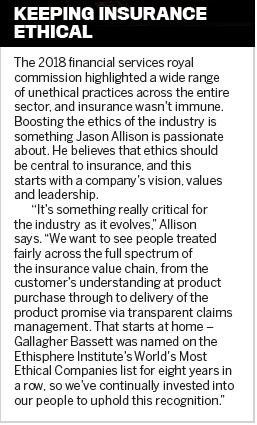

Accident and health insurance can be daunting for those who don’t know a lot about the product, but Gallagher Bassett’s Jason Allison tells IB how, with the right support, the field presents considerable opportunities for savvy brokers
What qualities make a good accident and health insurer? It’s a question that weighs on the minds of many brokers around the country. Given the broad scope of coverage involved – and the simple fact that not all providers are created equal – it’s easy to be overwhelmed by the prospect of working in this space.
Yet it doesn’t have to be this way. Jason Allison, national business development manager at Gallagher Bassett, is highly conscious of the qualities that make for a good accident and health insurance provider. Chief among them is a company with a good track record of claims management, whether that’s done in-house or outsourced via a third-party administrator (TPA).
“In the accident and health space, travel and expat provide you with significant volume, and for the most part, these claims are pretty straightforward – curtailment, lost baggage, delayed flights and so on,” Allison explains. “Some of them will need more of a personal touch than others, of course – but they are not particularly complex.”
What is important, he adds, is that a claims provider has the ability to deal with more sensitive and unexpected situations if and when they do arise. This is especially key in cases involving personal injury or sickness, when responsive service is required to assist claimants.
“Further, a business must have requisite scale – in other words, the ability to flex to the surrounding circumstances while still maintaining quality,” Allison says. “A strong, consistent claims service is one that will be able to meet market needs, both during and after a major event, not just during day-to-day services.”
Systems should also be transparent, with accessible data, to assist with future portfolio underwriting decisions.
“Given the attention the royal commission attracted and the reforms that have taken place for the General Insurance Code of Practice, it’s essential to work with a provider who is up to speed with the relevant legislation,” Allison says. “While the onus is on you to keep up to speed with industry requirements, you want to make sure your provider is invested, too – look at what sort of training sessions or broker education options are provided in the market.”
Emerging risks and opportunities
Brokers looking to operate within the accident and health space should also be aware of the various risks that populate the industry. Having previously worked as an underwriter himself, Allison cautions against taking a generalist approach, instead emphasising the need for more granular risk awareness and assessment.

At a macro level, this pressure has been driven by increased incidents of large-scale weather events, seismic events and political unrest, Allison notes. That’s driven a natural rise in premiums, and the data gathered accordingly affects future forecasts.
“The other risks we’re seeing are more to do with risk selection and product specs,” he says, which has affected corporate clients who are looking to provide some form of accident and health cover for their employees. There’s been a scaling back of coverage included in group-level policies as underwriters become more aware of the risks involved and look at the performance of similar policies in the marketplace. Additionally, clients are often wary of rising premiums for coverage that they might consider optional.
“If you go in and see your insurer one-to-one in a retail sense,” Allison explains, “they’ll probably send you for a medical assessment, ask some questions about your lifestyle and family history, and then you’ll be assigned a policy and premium based on that. There might be some exclusions, too, based on your own risk factors.”
But if you’re part of a corporate scheme, he explains, these calculations are made on the basis of population averages and other research, such morbidity rates and age. While these blanket arrangements can be better for some people, in other cases, they overlook fundamental high-risk health issues at the individual level.
This doesn’t just apply to health-related matters, either. It’s something that affects every facet of accident and health in the workplace, and brokers need to understand that they can’t just take for granted that corporate policies are comprehensive.
“The challenge underwriters have in attaining risk insights – and for businesses seeking cover – is working with these restrictions while not violating the privacy of their employees,” Allison says. “So, to that end, brokers need to be having comprehensive conversations about the coverage their clients are likely to need and presenting risk accordingly, whilst underwriters can leverage new information, such as Big Data, to better assess exposures.”
He notes that these discussions also touch on companies’ desire to be viewed as an ‘employer of choice’ in the modern workforce. Indeed, he suggests, it’s an effective way to raise the issue with clients.
“There are legal requirements on certain types of insurance in the workplace; however, in the main accident and health space, policies are what might be classed as optional,” Allison says. “But for businesses that are looking to capture and retain talent, they can serve as significant bargaining chips. If they’re not offering these policies, someone else will.”
The future of accident and health
Looking to the future of the field, Allison again emphasises the importance of size and scalability for insurers, TPAs and brokers alike. It’s a form of future-proofing, which in turn helps secure the future of the companies themselves.
“Companies need to be investing in these areas, because you don’t want to be caught out,” he says. “Insurance is constantly evolving – trends shift, systems can become obsolete, and the market moves on. You don’t want to be left behind.”
Allison also believes brokers will need to play an even greater role in risk management for their clients in the future.
“A key part of safety is looking at preventative measures,” he explains. “Not just on an underwriting front, either – it involves broader understanding of the data, legislation and social attitudes around a given issue. So, if you’re a broker in this market, you need to have that understanding so you can act as a conduit to your clients. It’s about much more than just a basic employee profile.”
One area where this is emerging in at the moment is workplace mental health, Allison notes. Employers and the public are more aware of the issues involved and their effects.
“We’re started to see more targeted underwriting on that front,” Allison says. “Policies aren’t just based on the physical risk of an industry anymore – we also have to look at how stressful the roles involved are and what sort of arc the industry is taking. Is it on an upward or downward swing? How is that affecting employees?”
Of course, how much of that filters through to the individual employee is up for debate, he notes, but having someone who’s able to communicate that nuance is crucial. \
“That’s why brokers play such an important role,", Allison says. “That’s why we invest so heavily in learning and development and other tools to ensure we’re doing right by brokers, by our customers and by the wider industry.”
